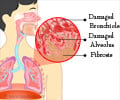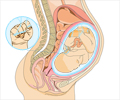Stem cells collected from the human amniotic membrane, one of the two fetal membranes forming during pregnancy and is usually discarded after a baby's birth can be used to slow the progression of pulmonary fibrosis scarring.

Idiopathic pulmonary fibrosis (IPF) is characterized by scarring of the lung tissue. Over time, the scarring (fibrosis) worsens until the lungs cannot take in enough oxygen, affecting the person's quality of life and eventually leading to death. While current medications (and in some instances, a lung transplant) can extend a patient's life beyond the three to five years previously predicted from time of diagnosis until death, there is no cure.
The cause of IPF is unknown, although many medical experts believe that it likely results from a combination of genetic and environmental factors. Growing evidence also suggests a link between inflammation and the development and progression of the lung's scarring. That information prompted the current study published in SCTM, according to Anna Cargnoni, Ph.D., who led the investigation under the supervision of CREM's director, Professor Ornella Parolini, Ph.D.
"Mesenchymal stromal cells derived from the human amniotic membrane (hAMSCs) display a marked ability to affect the body's immune system," she explained.
"They have been shown to reduce lung fibrosis in mice, possibly by creating a microenvironment that limits the evolution of chronic inflammation, which leads to scarring. However, the ability of hAMSCs to modulate the immune cells - and specifically B cells- involved in pulmonary inflammation has yet to be clearly described. That's what we sought to do in our study."
The team conducted their study on mice, beginning by inducing lung scarring with the drug bleomycin, which intratracheally instilled produces injury to the alveoli (the tiny air sacs in the lungs) and consequent lung fibrosis. They then injected one group of animals with freshly isolated hAMSCs and another group with hAMSCs expanded in vitro, to address the important question of how in vitro expansion affects the hAMSCs' therapeutic capabilities. The third group of animals, the control group, was treated with the saline solution used to inject hAMSCs but without the cells.
Advertisement
"We found that both the freshly collected and the expanded hAMSCs were able to control the recruitment, retention, and maturation of B cells in the diseased lungs. This is important because, in IPF patients, B cells form pulmonary aggregates with T cells, and continuously activate T cells creating a self-maintaining inflammatory condition.
Advertisement
"This preclinical study demonstrates that stem cells derived from the amniotic fluid have the ability to hamper inflammation and slow scarring in lung tissue," said Anthony Atala, M.D., Editor-in-Chief of STEM CELLS Translational Medicine and director of the Wake Forest Institute for Regenerative Medicine. "These cells could eventually be used for new treatments of a deadly lung disease for which there is still no known cause or cure."
Source-Eurekalert














